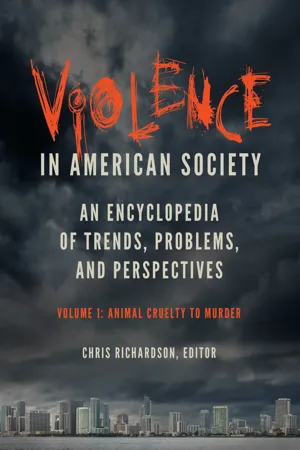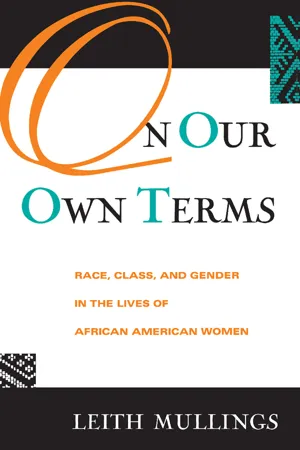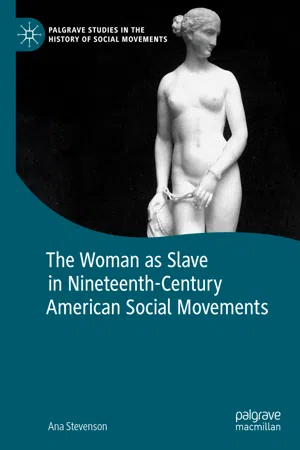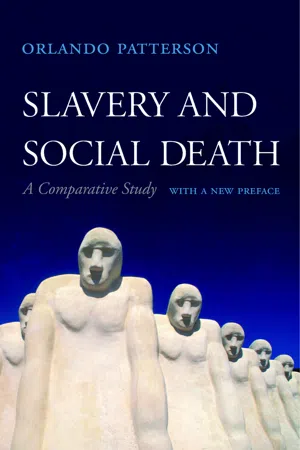History
Slavery and Gender
"Slavery and Gender" refers to the intersection of slavery and gender roles, particularly in the historical context. It encompasses the ways in which gender influenced the experiences of enslaved individuals, including the types of labor they were assigned, their treatment, and their opportunities for resistance. This area of study sheds light on the complex dynamics of power, exploitation, and resistance within the institution of slavery.
Written by Perlego with AI-assistance
Related key terms
Related key terms
1 of 4
Related key terms
1 of 3
5 Key excerpts on "Slavery and Gender"
- eBook - ePub
Violence in American Society
An Encyclopedia of Trends, Problems, and Perspectives [2 volumes]
- Chris Richardson, Chris Richardson, Chris Richardson(Authors)
- 2020(Publication Date)
- ABC-CLIO(Publisher)
Slavery and Human TraffickingHearing the voices of those who survived slavery and allowing their insights to help shape our understanding of human trafficking continues to be a difficult exercise for many Americans. It is clear, however, that some of these difficulties have arisen because the nature and practice of slavery have often been distorted in the media. This entry chronologically surveys some basic themes in the representation of American slavery and human trafficking. It begins with a description of “social death” as an essential aspect of slavery’s existence. Then it examines how the topic of slavery has been contextualized by American history, as well as contemporary culture. Finally, it identifies popular media productions that continue to represent the cultural and technological consequences of slavery and human trafficking.In his classic essay “Authority, Alienation and Social Death,” historian of comparative slave systems Orlando Patterson notes the profound misunderstandings that may occur when essential elements of slavery are ignored in any contemporary analysis of the phenomenon. In large part, these misunderstandings arise because of researcher bias. The perspectives of slavery’s victims are often ignored, usually under the guise of advocacy. The concept of “freedom,” for example, is often posed in opposition to slavery, but this is a misnomer that frequently leads to confusion about the nature of slavery itself. Generally, slavery refers to a kind of bondage characterized by the subjection of a person or group to the status of another’s property. However, its occurrence is never characterized by only the existence of such bondage or only the declaration of someone as belonging to another. Slavery occurs in tandem with other processes. According to Patterson (1982), “one dominant theme emerges [in comparative studies of slavery], which lends an unusually loaded meaning to the act of natal alienation: this is the social death of the slave” (38). With these words, Patterson is not insisting that slaves do not socialize. His point is that in virtually all cultures practicing human bondage, enslaved people completely lack social standing until they are liberated. They undergo a desocialization from their life as a free person and then an initiation into the slaveholder’s community as property. The initiation of a trafficked person into a new community as a slave, however, entails “the paradox of introducing him as a [social] nonbeing” (Patterson 1982, 38). In other words, upon capturing a victim, the slave trafficker must deny the captive person access to any evidence of their potential for an independent existence. This means that “although the slave is socially a nonperson and exists in a marginal state of social death, he is not an outcaste. The point must be emphasized in view of the easy use often made of the caste concept in interpreting American slavery and its post-emancipation consequences” (Patterson 1982, 48). Patterson’s point is an important one. He reminds readers that enslaved people have always needed to be intimate with their owners in order to obey them. Because slaves were believed to have no legitimate claim to social standing, their close proximity to owners was not deemed inappropriate. But this was quite the opposite in caste systems. - eBook - ePub
Foundations of Modern Slavery
Profiles of Unfree and Coerced Labor Through the Ages
- Caf Dowlah(Author)
- 2021(Publication Date)
- Routledge(Publisher)
In sum, slaveries existed since the time immemorial, although the scale and magnitude involved in physical ownership, dehumanization and commodification of labor power, and coercion and cruelty exercised to obtain coerced labor, varied widely through the ages and across various regions of the world. While some slave systems had accorded considerable protections and rights to slaves, even prohibited perpetual slavery—slavery of descendants of slaves, in others dehumanization of slaves and almost complete commodification of slave labor had been the hallmarks. Historical evidence also suggests that the lines of slavery often blurred the perimeters of race, gender, culture, religion, and economic standing of the victims, and such practices have received a widespread validation from governments, businesses, philosophers, and religious leaders throughout the world history.Although it sounds strange in the contemporary world, slavery, not free labor, indeed has been the most common and universal form of labor throughout world history—most settled societies incorporated the institution into their social structures, and few peoples in the world have not constituted a major source of slaves at one time or another (Eltis 1993). Free labor, on the other hand, is essentially a phenomenon of the modern period—it appeared as a significant ‘legal and cultural construct’ in the Anglo-American world of the eighteenth century when employers lost the legal right to invoke criminal penalties for premature departure or non-performance of laborers (Drescher 1999). - eBook - ePub
On Our Own Terms
Race, Class, and Gender in the Lives of African-American Women
- Leith Mullings(Author)
- 2014(Publication Date)
- Routledge(Publisher)
Women had the added burden of childbearing, frequently working up until childbirth and restarting soon afterward. Owens suggests that the general rule applying to enslaved women after childbirth was “make her do something, for as long as she hugs that sick house, shell never get well” (cited in Owens 1976, 40). Carrying their newborns on their backs, enslaved women returned to work in the fields, nursing their babies when they could. Sometimes slaveholders permitted enslaved mothers to spend extra time caring for children, which would be made up by additional work performed by the children’s father (Owens 1976, 200). The division of labor, to the extent that it existed, seemed geared toward facilitating the survival of the family. One of the ironies of slavery was that the disenfranchisement of both men and women meant that the enslaved family possessed no means by which one gender could control the other.In this period women of different classes emerged with distinct experiences, options, and constraints. Their lives were at least as different from one another in these respects as they were from the lives of men of their own classes. For Euro-American women, class distinctions intensified and the public/private dichotomy became more salient. In the early phases, women of the planter class had access to resources primarily through their husbands and fathers but could command some independence through participation in manufacturing, agriculture, and some commercial enterprises. The extent to which they were subject to the limitations of gender role ideologies was modified by demographic and technological conditions. The limited political rights of female indentured servants, and later of poor Euro-American women, were shared with the men of their class. In the early period, the division of labor was probably less extreme, and availability of land allowed a certain flexibility in the mobility structure. In later periods, these women too were affected by the emerging gender role segregation.The lives of enslaved women were very different. These women shared with men of their class a complete lack of property rights or even rights over their own bodies. They often did what was considered to be men’s work. They shared the reproductive burdens of both the planter’s wife and the indentured servant, but they were not entitled to protection of their sexuality or families, except that which they could muster themselves within the confines of the slave system. Here we find a major distinction between the lives of the free and the unfree. The division of labor by gender seems to have been greatest in the planter class. This was reflected in the household, and relationships seem to have been most patriarchal in the emerging merchant, planter, and artisan classes (see Farber 1973). - Ana Stevenson(Author)
- 2020(Publication Date)
- Palgrave Macmillan(Publisher)
proslavery ideologues, and other commentators embraced each of these approaches.As a result, the woman-slave analogy offered countless reformers a framework through which to begin to consider the relationship between different forms of oppression . Recent scholarship suggests that the inextricable connections between gender, race, and class were “powerfully theorized” during the antebellum era.48 In her analysis of the sexual contract and feminist responses to traditional contract theory, Carole Pateman comes closest to conceptualizing the comparison between slavery and the status of women as a theoretical approach. Since its earliest articulations, Sabine Broeck also argues, the “infamous and persistent use of the analogy of ‘women’ with and as ‘slaves’” has been at the center of feminist thought. This intellectual tradition has long made claims to women’s full humanity by aggressively constructing “a philosophical, political, and sociomaterial line between ‘woman’ and ‘slave,’ between ‘human’ and ‘thing.’” Such rhetoric provided what Broeck describes as “a springboard for white women to begin theorizing a catalogue of their own demands for an acknowledgement of modern, free subjectivity as antagonistic to enslavement.”49 However, while some scholars concede that the woman-slave analogy- eBook - ePub
Slavery and Social Death
A Comparative Study, With a New Preface
- Orlando Patterson(Author)
- 2018(Publication Date)
- Harvard University Press(Publisher)
The first danger to which our analysis alerts us is the error of all attempts to define slavery in modern legalistic terms. Yet the vast majority of works employ just such an approach. It would be tedious to give a long list of such definitions; 16 we note only a few of the better known. For J. K. Ingram “the essential character of slavery may be regarded as lying in the fact that the master was owner of the person of the slave.” 17 H. J. Nieboer, perhaps the most prominent author on the subject, also emphasizes property. 18 Perhaps the most frequently cited definition is that given by the League of Nations committee on slavery: “the status or condition of a person over whom any or all the powers attaching to the right of ownership are exercised.” 19 More recently, James L. Watson has deliberately rejected anthropological advances in the definition of the subject by harking back to Nieboer, claiming “that the property aspect of slavery must be accepted as primary—this is what distinguishes slavery from all other forms of dependency and involuntary labour.” 20 My objection to these definitions is not that I do not consider slaves to be property objects. The problem, rather, is that to define slavery only as the treatment of human beings as property fails as a definition, since it does not really specify any distinct category of persons. Proprietary claims and powers are made with respect to many persons who are clearly not slaves. Indeed any person, beggar or king, can be the object of a property relation. Slaves are no different in this respect. If we must use the property concept (an approach I prefer to avoid because of the inevitable confusions), we need to be more specific
Index pages curate the most relevant extracts from our library of academic textbooks. They’ve been created using an in-house natural language model (NLM), each adding context and meaning to key research topics.
Explore more topic indexes
Explore more topic indexes
1 of 6
Explore more topic indexes
1 of 4




